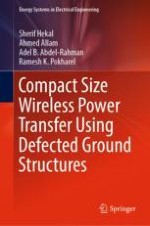This book addresses the design challenges in near-field wireless power transfer (WPT) systems, such as high efficiency, compact size, and long transmission range. It presents new low-profile designs for the TX/RX structures using different shapes of defected ground structures (DGS) like (H, semi-H, and spiral-strips DGS). Most near-field WPT systems depend on magnetic resonant coupling (MRC) using 3-D wire loops or helical antennas, which are often bulky. This, in turn, poses technical difficulties in their application in small electronic devices and biomedical implants. To obtain compact structures, printed spiral coils (PSCs) have recently emerged as a candidate for low-profile WPT systems. However, most of the MRC WPT systems that use PSCs have limitations in the maximum achievable efficiency due to the feeding method. Inductive feeding constrains the geometric dimensions of the main transmitting (TX)/receiving (RX) resonators, which do not achieve the maximum achievable unloaded quality factor. This book will be of interest to researchers and professionals working on WPT-related problems.
